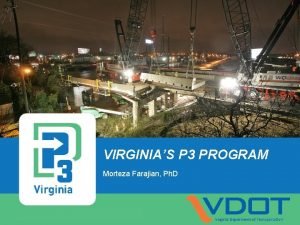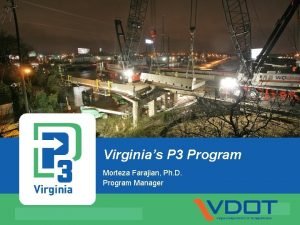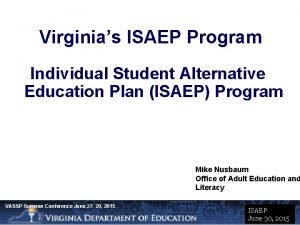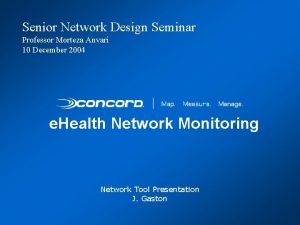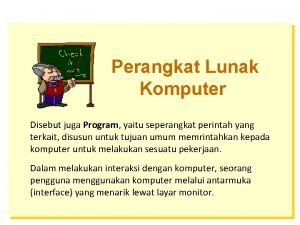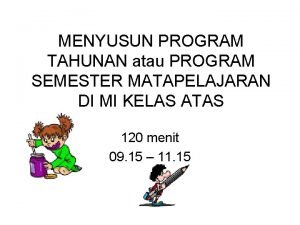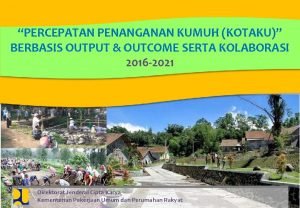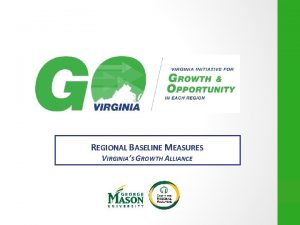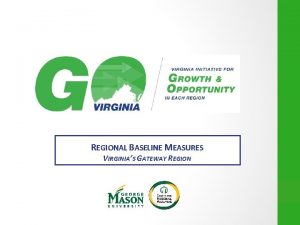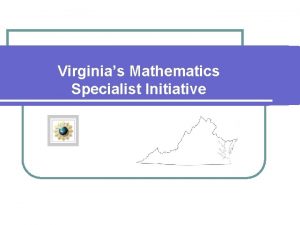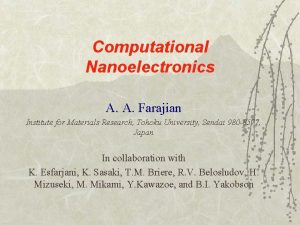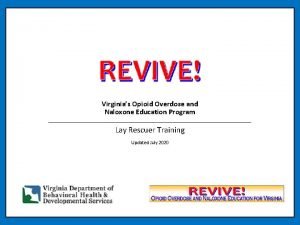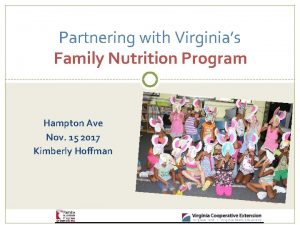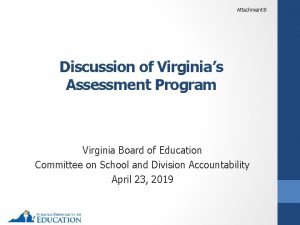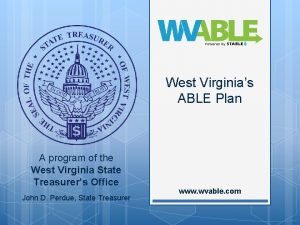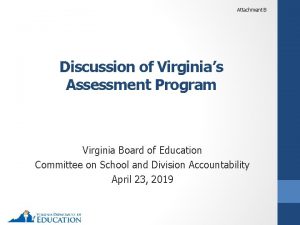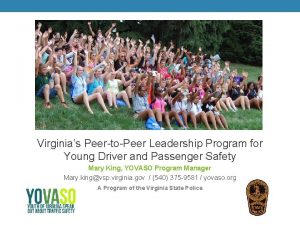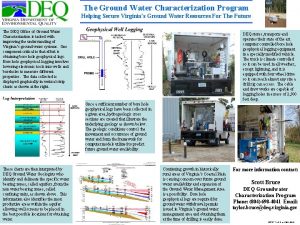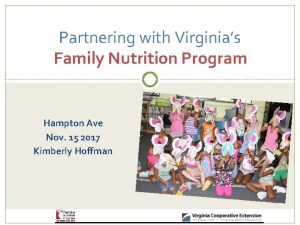Virginias P 3 Program Morteza Farajian Ph D





















- Slides: 21

Virginia’s P 3 Program Morteza Farajian, Ph. D. Program Manager

What is a good Public-Private Partnership (P 3) project?

Introduction n Ask the right questions: o o o What is a good project? What is the best delivery model for the project? What is the best risk allocation? n Project goals and objectives n Policy goals and objectives

Overview of P 3 s Delivery Models A Delivery Model Design-Bid. Build Design-Build -Operate-Finance Maintain Design-Build Full -Finance. Concession/ Operate. Developme Maintain nt Rights B Risk Allocation C D E Contractual Structure Payment Mechanism Financial Structure Public Responsibility Consultancy Contracts Service Management DBF Contracts Milestone Payment Public Contributions Private Responsibility Capital Markets Debt Availability Payment Private Equity DBFO Contracts Lease Full Concession/ Development Rights Revenue/Demand Based Infrastructure Funds Bank Debt

Is P 3 the right delivery model for a particular project?

Vf. M in the Context of Virginia’s P 3 Project Delivery Framework Initial VFM

Vf. M in the Context of Virginia’s P 3 Project Delivery Framework

Vf. M in the Context of Virginia’s P 3 Project Delivery Framework Initial VFM

Vf. M in the Context of Virginia’s P 3 Project Delivery Framework Final VFM

P 3 Project Screening High-Level Criteria: Detail-Level Criteria: • Ability to Transfer Risk • Public Need and Benefits • Funding Requirement • Economic Development • Ability to Raise Capital • Market Demand for P 3 Delivery • Complexity of Effectively Leveraging Private Sector Innovation/Expertise • Stakeholder Support • Addresses Priorities in State, Regional and/or Local Transportation Plan • Project Efficiencies through P 3 Delivery • Technical Feasibility • Systematic Interface and Compatibility • Financial Feasibility • Legal/Legislative Feasibility • Project Risks 10

Overview of P 3 s Value for Money A Vf. M analysis is undertaken to help identify whether a P 3 delivery option provides value as compared to a traditionally-financed approach (Public Sector Comparator or “PSC”) on both a quantitative and qualitative basis. Vf. M P 3 Delivery Model PSC Delivery Model ■ Public sector financed ■ Private sector financed ■ DBB approach, operated and maintained by MTA ■ DBFOM responsibilities performed by private sector ■ Limited transfer of risk to private sector ■ Allows risk transfer to private sector In general, long term value for money can be achieved by: – Accelerating delivery of projects – Proper allocation/transfer of risks – Providing incentives to the private sector for the delivery of quality services – Encouraging innovative delivery solutions by use of an “outputs” specification approach – A long-term partnership contract provides a degree of cost certainty to government and revenue (availability payments) security to the bidder

Case Study: Transform 66 P 3 Project (Virginia)

Case Study I-66 Express Lanes (Outside the Beltway): • Primary commuter route in Northern Virginia • 25 miles in length • Runs in an east-west direction between US 15 in Prince William County, VA, and I-495 (Capital Beltway) in Fairfax County, VA • Dynamically tolled • Nine Toll Segments 13

Preferred Alternative Mainline Cross Section Flexible barrier with buffer, median for potential future transit (with auxiliary lanes, if needed) 14

Project Timeline n Summer 2011 – Environmental Process Initiated (NEPA) n November 2013 – Record of Decision (ROD) issued on Tier 1 NEPA n August 2015 – Commissioner makes Finding of Public Interest (FOPI) to initiate procurement under PPTA based on three delivery models (DBFOM, DBOM and DB-ATC)Transportation Public-Private Partnership Advisory Committee concurs with Commissioner’s FOPI n September 2015 – CTB authorizes VDOT to proceed with the procurement, Request for Qualifications. n October 2015 – VDOT received 13 Statement of Qualifications (SOQ) n December 2015 – VDOT receives indicative financial proposals from Short-Listed Proposers and selects toll concession as the preferred delivery model n December 2015 – VDOT briefs CTB and Transportation Public-Private Partnership Advisory Committee n December 2015 – VDOT posts a draft request for Proposals (RFP) 15

Process from RFQ to RFP 16

Process from RFQ to RFP Delivery Model DB-ATC DBOM DBFOM Step 1: SOQs Short-List Proposers Step 2: Conceptual Financial Proposals 5 5 3 Stipends paid to responsive Short-Listed Proposers for non-selected delivery methods Delivery Model Selected; Qualified Proposers Announced RFP 17 Outcome: Delivery Methods reduced from 3 to 1

Summary of Requirements n Term = 50 years n Maximum amount of Commonwealth contribution is $600 M. n Other sources of Project financing include: o Private equity o TIFIA o Private Activity Bonds (PABs) n Commonwealth receives funding (fixed amounts) for transit elements of Project. n Commonwealth receives $350, 000 in net present value over term of contract from the Developer that can be used for future corridor enhancements. n Commonwealth will receive a share of the revenue if Project generates more revenue than expected.

Summary of Requirements ($ millions) Concession DBOM DB-ATC Low High Upfront Public Funding (148) 600 416 1, 420 564 1, 218 Future Corridor Improvements 1 350 241 289 248 320 (250) 498 (1, 131) (175) (898) (300) Net Public Funding (1) Present Value. Note: Dollars in millions and in nominal terms, unless otherwise noted. Present value calculations are discounted at 6. 14% as of November 15, 2020.

Comparison with Past P 3 Deals Pocahontas Parkway 495 Express Lanes Midtown/ Downtown Route 460 95 Express Lanes Transform 6 6 Public Funding 0 495 582** 1, 150 83 0 Private Equity 141 630* 33 0 280 1, 522 HOV usage / Route 1 upgrades 0 Transurban. Fluor/Lane Cintra/ Meridiam/ Ferrovial Potential Future Liabilities Team Figures in millions 20 0 HOV usage $700 M+ N/A Transurban/ Fluor/Lane Macquire/ Skanska Ferrovial (hand over to senior lenders) *Deal restructured in 2014 (cancelled) ** Additional public funding invested after financial close to reduce tolls

Virginia’s P 3 Program Morteza. Farajian@P 3. virginia. gov www. p 3 virginia. org
 Morteza farajian
Morteza farajian Morteza farajian
Morteza farajian Isaep model
Isaep model Morteza farajian
Morteza farajian Morteza rahmatian
Morteza rahmatian Morteza anvari
Morteza anvari Morteza
Morteza Cost analyst
Cost analyst Morteza maleki
Morteza maleki Data gathering procedure example
Data gathering procedure example Sequential program and an event-driven program?
Sequential program and an event-driven program? Perangkat lunak komputer disebut juga dengan....
Perangkat lunak komputer disebut juga dengan.... Merancang program tahunan dan program semester
Merancang program tahunan dan program semester Microsoft excel merupakan aplikasi.... *
Microsoft excel merupakan aplikasi.... * Program aplikasi pengolah angka adalah
Program aplikasi pengolah angka adalah Memulai microsoft word
Memulai microsoft word Program zedinjena slovenija
Program zedinjena slovenija Outcome program kotaku
Outcome program kotaku Public xxx
Public xxx Xilinx university program
Xilinx university program Seznam.cz najdu tam co neznam m
Seznam.cz najdu tam co neznam m Steph westwood writing program
Steph westwood writing program
